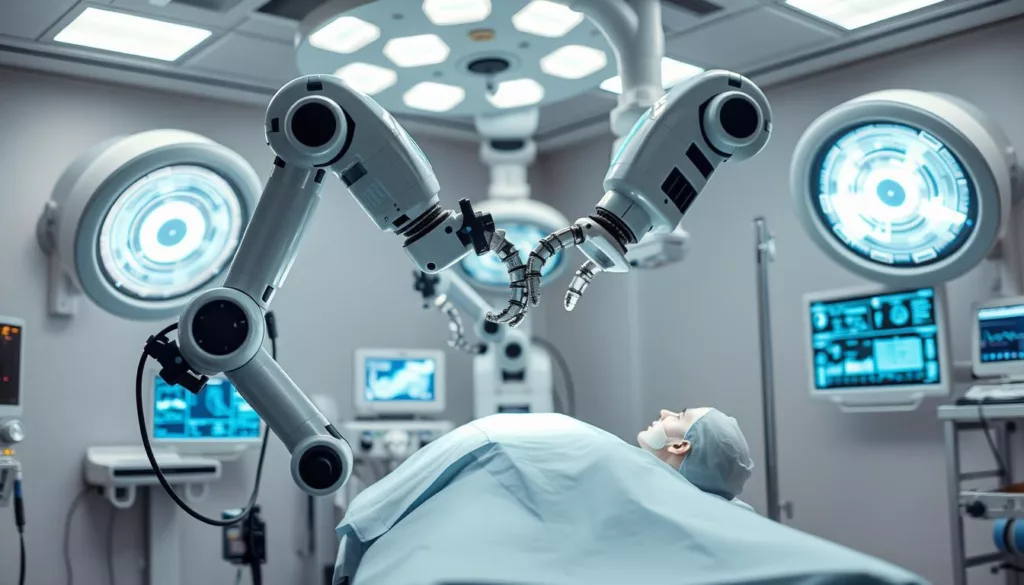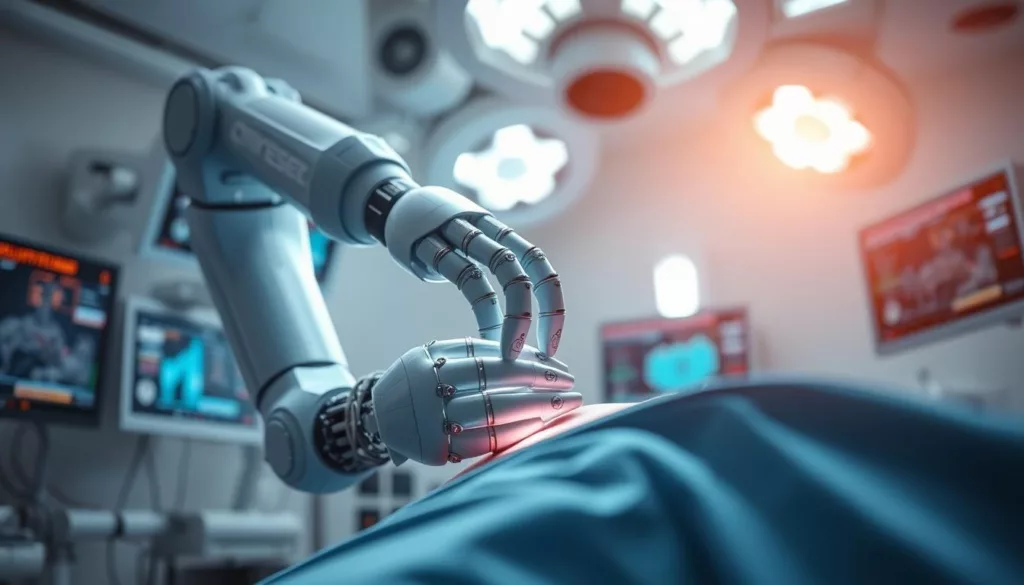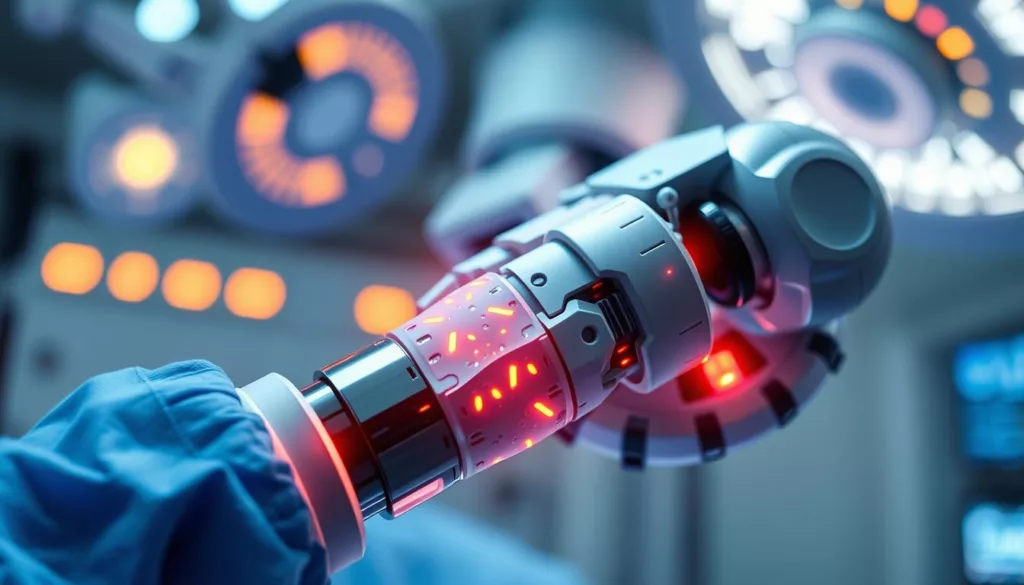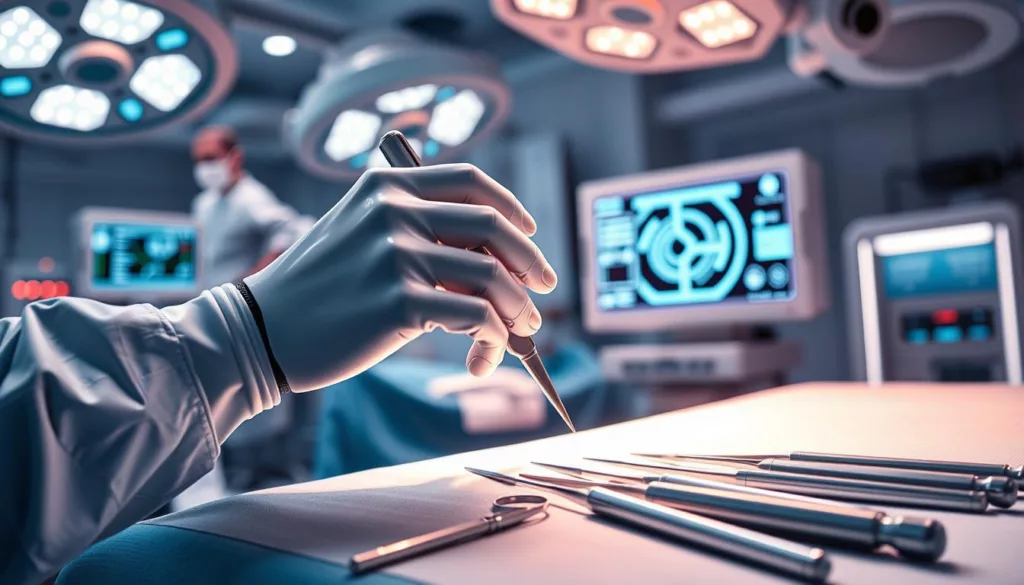Tactile sensors play a key role in robotic-assisted surgery. They have changed the way surgeries are done by improving precision. Tactile sensors let surgeons feel what they’re doing through haptic feedback. This is crucial for surgeries that need a high level of precision.
These sensors give important feedback during surgery. They make it easier and safer to move instruments during operations. We aim to give you a detailed look at how tactile sensors are changing surgery. We’ll show their benefits and how they’re used in the medical field.
Key Takeaways
- Tactile sensors enhance precision and control in robotic-assisted surgeries.
- Haptic feedback is essential for improving surgeon’s tactile perception.
- Robotic surgery advancements rely heavily on sensor technology.
- Implementing tactile sensors contributes to better patient outcomes.
- Continued research will optimize the use of tactile sensors in surgery.
Overview of Robotic-Assisted Surgery
Robotic-assisted surgery is changing surgery for the better. It introduces new methods that help both surgeons and patients greatly. These systems improve the skills of medical teams by allowing for less invasive and more accurate operations.
Definition and Functionality
Robotic-assisted surgery uses robots to aid surgeons during operations. These robots offer sharp 3D views and very precise control over instruments. They are equipped with special sensors. This helps improve how surgical tools work, giving better feedback in the middle of surgery.
Key Advantages Over Traditional Surgery
Moving to robotic-assisted surgeries has many benefits. For patients, it means quicker recovery because their bodies are less harmed. They feel less pain afterward, getting them back to their normal lives faster. For surgeons, advanced sensors make it easier to do complex procedures, making surgeries safer and more effective.
Understanding Tactile Sensors
Tactile sensors are a big leap in surgical technology. They help detect physical contact and give crucial feedback. By using these sensors, robotic systems can measure pressure, texture, and temperature. This data helps surgeons make better decisions.
What Are Tactile Sensors?
Tactile sensors mimic how humans feel touch. They collect data by touching materials. In surgery, they let robots work with high precision and safety. This means surgeons get accurate information fast during surgery.
Types of Tactile Sensors Used in Surgery
There are different tactile sensors used in surgery. Each one has its special use. Here’s a list of the main types:
| Type of Sensor | Working Principle | Applications |
|---|---|---|
| Piezoresistive Sensors | Resistance changes with pressure | Detecting force and pressure in surgical tools |
| Capacitive Sensors | Capacitance changes with force | Monitoring contact with tissues and organs |
| Optical Sensors | Light changes with pressure | Providing detailed surface texture feedback |
These technologies improve sensory feedback in robotic surgery. This boosts surgery success. For more on sensor tech in robots, visit this link.
Enhancing Precision in Surgical Procedures
Tactile sensors are key in improving robotic surgery precision. They give real-time feedback, enhancing surgeons’ fine motor skills. This allows for better control of instruments during important surgeries. The use of tactile sensors is vital for minimizing risks in complex operations.
Role of Tactile Sensors in Fine Motor Skills
Tactile sensors offer essential data about resistance from different tissues. Surgeons use this data to fine-tune their techniques. This ensures a precise touch, crucial for fine motor skills. Improving patient outcomes with tactile sensors is thus made possible. With this feedback, surgeons can handle difficult environments better. This boosts their accuracy in performing surgical tasks.
Impact on Surgical Outcomes
Tactile sensors have a proven impact on surgical results. They are especially useful in tasks needing precision like suturing. Studies show they can lower the risk of complications, increasing success rates. By focusing on robotic surgical precision, recovery times decrease. Overall health outcomes improve too. For more on sensor technology, visit this resource.
The Importance of Feedback Mechanisms
Feedback mechanisms are vital in robotic-assisted surgery. They help surgeons feel what they’re doing through haptic feedback. This works by collecting real-time data during surgery. This makes the experience better for everyone involved.
Real-Time Data for Surgeons
Surgeons get huge advantages from immediate feedback. They know exactly where their tools are and how much pressure they’re applying. This stream of info helps them operate with more precision and confidence. It shows how robotic surgery is really pushing boundaries.
Reducing Human Error
It’s super important to make fewer mistakes in surgery. Advanced feedback helps by making decisions more informed. Studies reveal that haptic feedback makes surgeries safer. It also improves how surgeons learn and train. This boosts both the safety and effectiveness of surgeries.
Applications of Tactile Sensors in Various Surgeries
Tactile sensors are key in many surgeries, improving accuracy and patient results. They are especially useful in complex operations needing touch feedback. These sensors have pushed forward surgeries like cardiac, orthopedic, and neurosurgery.
Cardiac Procedures
In heart surgery, tactile sensors help doctors with delicate tissues and better suturing. They give important feedback, aiding in tissue handling. This leads to more accurate and safer heart surgeries with the help of medical robots.
Orthopedic Surgery
For bone-related surgeries, tactile sensors are crucial. They help in joint reconstructions and putting in implants safely. The feedback from sensors ensures accurate implant placement, improving surgery results and recovery.
Neuro Surgery
In brain surgery, tactile sensors play a big role in handling brain tissue safely. They guide surgeons through critical brain areas. Sensors make surgeries safer by providing essential data, as discussed in studies.
| Surgery Type | Specific Benefits | Tactile Sensor Role |
|---|---|---|
| Cardiac | Improved suturing accuracy | Real-time feedback on tissue response |
| Orthopedic | Minimized tissue damage | Control of applied forces |
| Neuro | Enhanced navigation safety | Tissue interaction monitoring |
Comparing Tactile Sensors and Visual Feedback
In the world of robotic-assisted surgery, using different feedback mechanisms is key. It helps make surgeries more precise and safe. Tactile sensors and visual feedback are important. They each bring their own benefits to the table. When we look closely, we see what each does best and where they fall short.
Limitations of Visual Feedback
Visual feedback is important during surgery. But it has some downsides. Surgeons might not always feel how hard they press, leading to problems like hurting tissues or not applying enough force. They may also miss small changes in how tissue feels or its resistance. This could lower how well the surgery goes.
Complementary Roles in Surgery
Tactile sensors have a big role in exploring sensory feedback in robotic surgery. These sensors pick up on pressure and texture changes. They give surgeons up-to-date info that adds to what they see. By using tactile sensors with visual feedback, we get a fuller picture. This mix helps surgeons do better by filling in what each method lacks alone. This leads to better surgery results.
Advancements in Tactile Sensor Technology
Tactile sensor technology is making big leaps forward. This progress impacts robotic surgery in many ways. Major areas of improvement include making sensors more sensitive, smaller, and easier to integrate with robots.
Using the latest methods is key for advancing how tactile sensors are used in surgery. This makes the tools surgeons use more dependable and easier to handle.
Innovations Leading the Field
New technology has brought about flexible tactile sensors. These sensors are better at adjusting to different shapes and actions they meet during surgery. Key advances include:
- Enhanced sensitivity: They can now sense tiny changes in pressure, boosting feedback during operations.
- Miniaturization: These smaller sensors fit easily into robotic arms, while still working perfectly.
- Integration with AI: Smart algorithms that process data right away, helping make quick changes during surgery.
Future Trends in Sensor Development
The future looks bright for tactile sensors, with a shift towards multi-modal sensors. Such devices could collect various kinds of data, thanks to different sensing technologies. This adaptability is vital for broadening the uses of robot-assisted surgery and enhancing the effectiveness of tactile sensors in operations.
Expected future directions include:
- Better cooperation between sensor technologies and robots.
- More use of smart sensors that adjust to the needs of each surgery.
- Creation of platforms where surgery is supported by multiple data types for better decision-making.
Challenges in Implementing Tactile Sensors
Tactile sensors could make robotic surgery much better. But, there are big challenges to using them well. Solving these problems is key for them to help in surgeries.
Technical Hurdles
Making sure tactile sensors last long and work well in surgery is tough. Some important points are:
- Sensor Longevity: They need to keep working well, even after many uses.
- Integration Complexity: It’s hard to mix new sensors with the robots we already have.
- Data Accuracy: The sensors must give correct feedback in all kinds of surgeries.
Adoption in Medical Practices
Hospitals are slow to start using tactile sensors. This is because:
- Cost: They cost a lot at first, which can stop hospitals from getting them.
- Training Requirements: Surgeons and their teams need a lot of training to use these new tools right.
- Clinical Validation: Before everyone accepts these sensors, they have to prove they make surgeries better.
| Challenge | Description | Impact |
|---|---|---|
| Sensor Durability | Ensuring sensors retain functionality over time and usage. | Potential for sensor failure during critical procedures. |
| Integration Issues | Difficulty in combining new sensors with existing technologies. | Increased operational complexities and risks. |
| Cost Barriers | High costs can limit access to state-of-the-art technologies. | Slower innovation adoption in surgical environments. |
| Training Needs | Requirement for extensive training programs for medical staff. | Extended onboarding timelines and potential resistance to change. |
Case Studies Showcasing Success
Robotic surgery has been greatly improved by tactile sensors. These sensors help doctors perform better during surgery and train more effectively. They have made a big difference in how well patients do after surgery.
Example 1: Enhanced Outcomes
A study showed how tactile sensors were used in a tough heart surgery. They gave doctors real-time feedback, helping them make better decisions. This led to fewer complications and quicker recovery times for patients.
This study proves the value of tactile sensors in improving care. It shows their critical role in making surgeries safer and more precise.
Example 2: Improved Surgical Training
In another study, tactile sensors were used to teach new surgeons. They got hands-on feedback during practice, making their training more effective. This method has helped new doctors build their skills and confidence quickly.
This approach is changing how doctors are trained. For more info, check out case studies in robotic surgery. It’s preparing them for better performance in future surgeries.
| Case Study | Application | Outcome |
|---|---|---|
| Cardiac Procedure | Tactile feedback during surgery | Reduced complications and faster recovery |
| Surgical Training | Simulation with tactile sensors | Enhanced skills and increased confidence |
The Future of Robotic-Assisted Surgery
Looking into the future, the growth of touch-sensing technology in robot-assisted surgery is promising. It will bring smarter and more flexible tools, integrating with top-notch robotics. These advances will improve how precisely and efficiently surgeries are done, showing our commitment to top-quality surgical solutions.
Predictions for Tactile Sensor Evolution
We expect future robotics to blend in things like augmented reality (AR) and machine learning. This mix will allow for immediate data handling and better surgery decisions, boosting surgeons’ skills. With ongoing progress, sensors will give finer feedback, fitting a wide range of surgery types.
Potential Impact on Patient Care
These steps forward will significantly change patient care. With better sensors, surgeries will likely have more success, fewer issues, and quicker healing times. Such sensor use in care will lead to better life quality for those having surgeries, underscoring our commitment to healthcare innovation.






